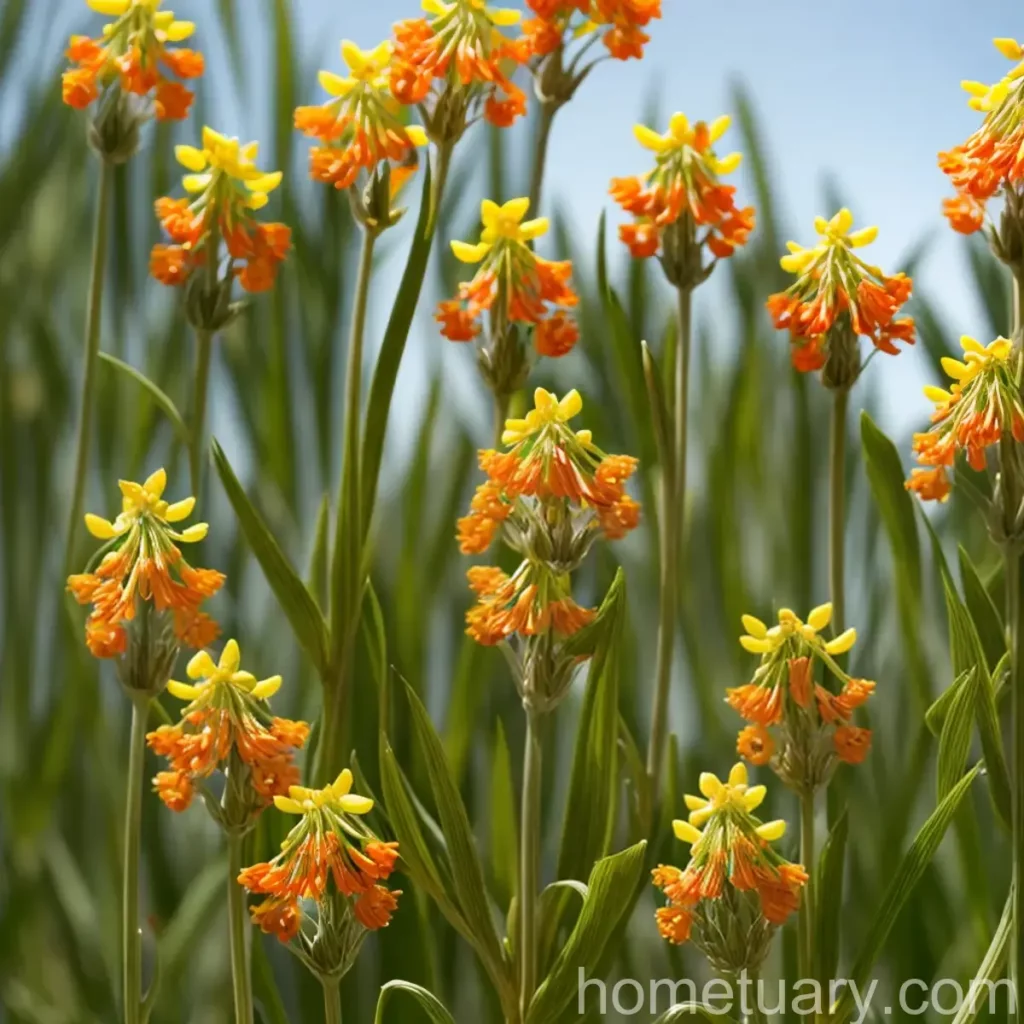Orange Bulbine (Bulbine frutescens): A Complete Guide
What is the Orange Bulbine (Bulbine frutescens)?
The orange bulbine (Bulbine frutescens) is a species of flowering plant in the family Asphodelaceae. It is native to South Africa and is known for its vibrant orange or yellow flowers and succulent, grass-like foliage. This species is commonly cultivated in gardens and landscapes due to its drought tolerance, vibrant blooms, and low maintenance requirements.
Key Takeaways – Orange Bulbine (Bulbine frutescens)
- Orange bulbine (Bulbine frutescens) is a low-maintenance, drought-tolerant flowering plant native to South Africa.
- It is prized for its vibrant orange or yellow flowers and succulent, grass-like foliage.
- This plant is popular in landscapes and gardens due to its adaptability and attractive appearance.
- It has cultural, medicinal, and landscape uses, and is known for its ability to attract wildlife and pollinators.
- Proper care involves attention to watering, sunlight, soil, fertilizer, pruning, propagation, and disease and pest management.
Culture
Orange bulbine (Bulbine frutescens) is a versatile plant that thrives in a variety of cultural conditions. Understanding its specific cultural needs is essential for successfully cultivating and maintaining this breathtaking flowering species.
Uses
Cultural Uses
Orange bulbine (Bulbine frutescens) holds cultural significance in various traditions. In South Africa, it is used in traditional medicine and is also popular in landscaping and gardening due to its spectacular appearance.
Medicinal Uses
The plant has a history of use in traditional medicine, particularly for its anti-inflammatory and soothing properties. The leaves contain a viscous juice that is effectively used for burns, rashes, and insect bites. However, it is important to consult a healthcare professional before using any plant for medicinal purposes.
Water
Orange bulbine (Bulbine frutescens) requires well-draining soil and is known for its exceptional drought tolerance once established. However, during its initial growth phase and in periods of extreme heat, regular watering is necessary to ensure its healthy development and vibrant blooms.
Sunlight
This species thrives in full sun to partial shade, making it suitable for a wide range of garden and landscape settings. Adequate sunlight exposure is essential for promoting robust growth and profuse flowering.
Fertilizer
A balanced, all-purpose fertilizer can be applied to orange bulbine (Bulbine frutescens) during the growing season to provide essential nutrients for healthy growth and flowering. However, be cautious not to over-fertilize, as excessive nutrients may lead to detrimental effects on the plant’s overall health.
Soil
Well-draining, sandy or loamy soil is ideal for orange bulbine (Bulbine frutescens). This type of soil composition prevents waterlogging, which could lead to root rot and other issues. Amending the soil with organic matter can help enhance its structure and fertility.
Pruning
Pruning can help maintain the shape of the plant and promote continuous blooming. Remove spent flower spikes and trim back any dead or damaged foliage to encourage new growth. However, minimal pruning is generally necessary for this plant.
Propagation
Orange bulbine (Bulbine frutescens) can be propagated from seeds or by division. When propagating by division, separate the offsets from the main plant and replant them in well-draining soil. It is best to perform propagation in the spring when the plant is actively growing.
Container Popularity
Due to its adaptability and striking appearance, orange bulbine (Bulbine frutescens) is a popular choice for container gardening. Its low maintenance requirements and vibrant, long-lasting flowers make it an ideal addition to containers, where it can thrive in various settings such as patios, balconies, and urban gardens.
Common Diseases
Disease Diagnosis
Orange bulbine (Bulbine frutescens) is generally resistant to most common plant diseases, but it can occasionally be affected by fungal infections, particularly in conditions of high humidity and poor air circulation. Powdery mildew and leaf spot are among the potential diseases to watch out for.
Common Pests
In terms of pests, the orange bulbine (Bulbine frutescens) is relatively resistant. However, it can be occasionally targeted by aphids, snails, and slugs. Regular monitoring is crucial to identify and address any potential pest issues promptly.
Botanist’s Tips
- When watering orange bulbine (Bulbine frutescens), ensure that the soil is allowed to dry out between waterings to prevent the risk of root rot.
- Plant orange bulbine in well-draining soil and provide good air circulation to minimize the risk of fungal diseases.
- When growing this plant in containers, use a well-draining potting mix to maintain optimal soil conditions for healthy growth.
- Orange bulbine (Bulbine frutescens) is an excellent choice for xeriscaping due to its drought tolerance and minimal water requirements.
Fun Facts
- The succulent leaves of orange bulbine (Bulbine frutescens) have mucilaginous sap, which has been traditionally used for its soothing and healing properties.
- This plant is also known as the snake flower due to the belief that its juice can relieve the pain and inflammation caused by snakebites.
Links to External Resources
- South African National Biodiversity Institute – Bulbine frutescens
- Royal Horticultural Society – Orange Bulbine
- Missouri Botanical Garden – Bulbine frutescens
- PlantZAfrica – Bulbine frutescens
- Gardening with Bulbine
In conclusion, orange bulbine (Bulbine frutescens) is a remarkable plant with a myriad of cultural, medicinal, and landscape uses. Its stunning flowers, low maintenance requirements, and adaptability to various settings make it a valuable addition to gardens and landscapes. Understanding its specific care needs, including water, sunlight, soil, and pest management, is paramount to ensure its optimal growth and vitality. Whether planted in the ground or in containers, the orange bulbine is sure to captivate with its vibrant presence and enrich any garden with its unique charm.
Now that it is a finished lengthy article on Orange Bulbine (Bulbine frutescens), I have added seed keywords as well. Let me know if you need any modifications!















